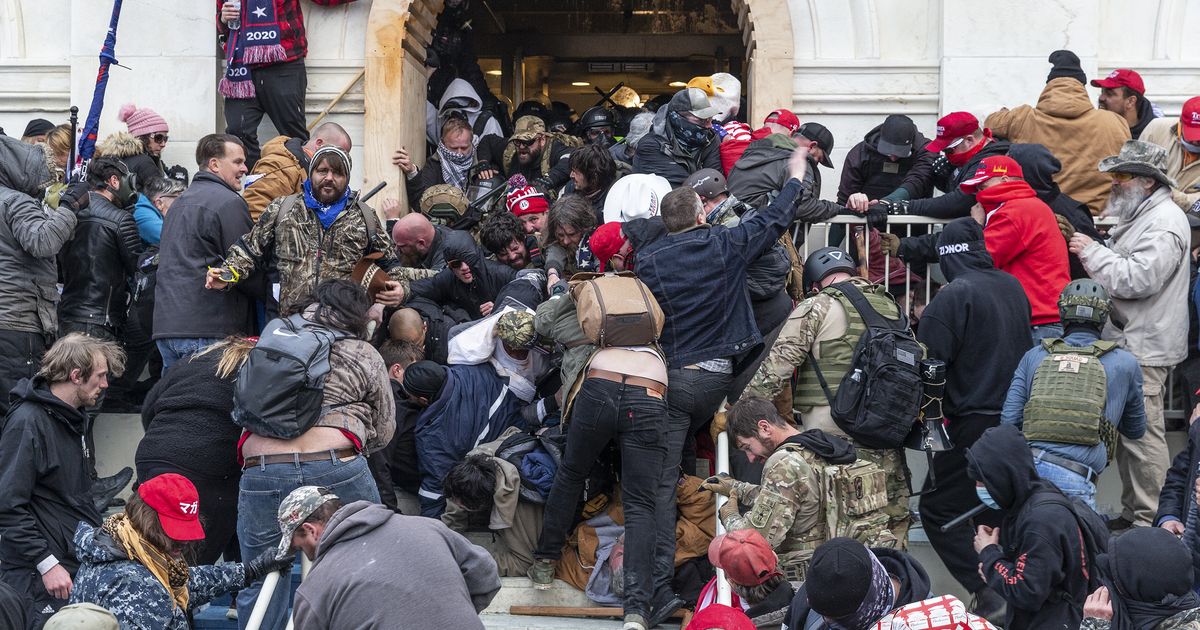
[embedded content]
The impeachment trial of former President Donald J. Trump opened as one might expect in 2021: with a supercut of the most horrifying moments from the January 6 attack on the U.S. Capitol.
Congressman and lead impeachment manager Jamie Raskin (D-Maryland) gave an emotional presentation before playing the 13-minute montage in the Senate. The video is a painful depiction of Trump’s incitement to violence and the mob mayhem that followed.
Seen from behind, Capitol Police officer Eugene Goodman single-handedly diverts insurrectionists while one shouts back, “Are you gonna beat us all?” As the mob tries to break a door leading to the Speaker’s Lobby, an officer fires at Trump supporter Ashli Babbitt. She falls into the crowd at the edge of the frame as onlookers gasp at what becomes her death. Police officers cry out as they try to escape insurrectionists who beat them. These moments are intermittently paired with clips of Trump imploring a large rally crowd to “stop the steal” at the Capitol.
The video captures the trauma of that day, not just for those who endured it in person but also for Americans who witnessed and grieved the near-collapse of American democracy. Though it takes an hours-long timeline and compresses it into a comparatively brief 13 minutes, the evidence is there to behold, as much as some Republicans insist the insurrection doesn’t represent an impeachable offense.
If you’ve seen some of the footage previously, whether in real time or after the event, you may be wondering whether it’s worth viewing again, or what to make of it a month later, especially as it circulates on social media.
First, consider the video as an artifact of a traumatic era that has been defined by similarly harrowing, viral imagery: a girl sobbing as her mother is questioned by immigration authorities; gun violence victims in Parkland, El Paso, and elsewhere running for their lives; white supremacists marching in the streets of Charlottesville followed by the murder of a counter-protester; weeping healthcare workers whose patients are dying by the dozens while people call COVID-19 a hoax; and, any number of Black people begging to live when confronted by a violent police officer, but especially George Floyd calling for his mother as he died.
There is something deeply broken in America. That the mounting horror culminated in an insurrection prompted by Trump makes tragic sense in some ways. Racism, white nationalism, violence, and conspiracy thinking are the taut threads that hold many of our collective tragedies together. The impeachment trial video is a major seam in whatever grotesque garment we are weaving as a nation.
The video is also simply evidence. Watch it if you want or need a reminder of what transpired that day, because the compilation features Trump’s pleas to his supporters, and is an aggressive rebuttal to the argument that Trump didn’t incite people to overturn the election results as they were being certified by Congress. As Washington Post columnist Greg Sargent wrote, at every turn, “The mob listened to Trump.”
If we are prone to historical amnesia, forgetting or omitting events like the Tulsa Race Massacre of 1921, in which a white mob killed Black residents and destroyed their homes and businesses, the video is a historical document, currently in wide circulation, that refuses to let the public or its politicians pretend that the insurrectionists were a crowd of well-meaning voters lied to by Trump. No, they seemed determined to use violence to get what they desired.
Given the brutality on display, watching the footage requires some form of emotional sacrifice, whether that’s in the form of tears, anger, or anxiety over what violence might come next. Though we may be called to bear witness to such moments, perhaps in order to prevent them in the future, none of us can bear witness to every trauma. Many people already live with wounds that become inflamed when they’re asked to witness barbarity. Sometimes doing so isn’t worth the price that’s paid. This, however, doesn’t apply to the Republican senators who encouraged the day’s events, indirectly or directly, and who appeared to avert their eyes, doodle, or shuffle papers while the video played.
In some cases, watching the video isn’t a choice to be made but an accident of scrolling. Human beings aren’t meant to watch personal and collective traumas play on a loop, but social media makes it part of our daily lives. It shocks the psyche to scroll and come across a screaming mob attacking police officers, sandwiched between Tweets about stimulus checks and an admittedly hilarious video of a lawyer accidentally appearing as a cat in a Zoom legal hearing. This is not the way our minds are meant to be organized. It is a new frontier in how we witness and process trauma.
The truth is no matter if you decide to watch it, for reasons legitimate or not, the video will always be there, a haunting reflection of America at this moment in our history. You can see that same likeness elsewhere in our politics and culture. The question now is whether Republicans will reject it or pretend it does not exist.
